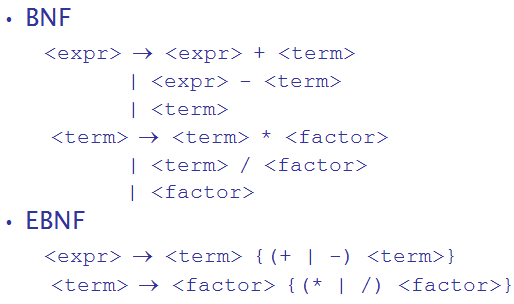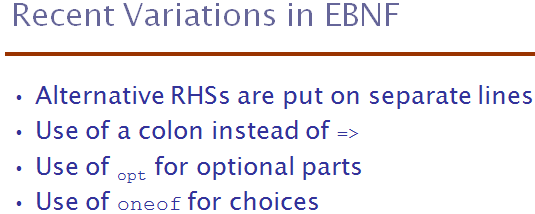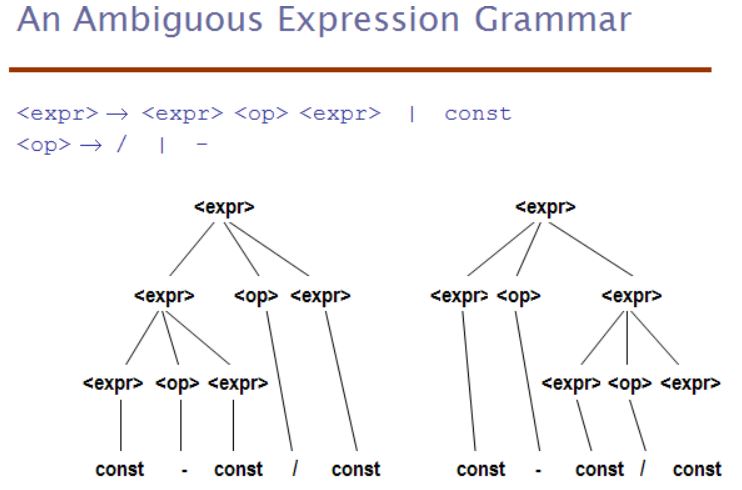
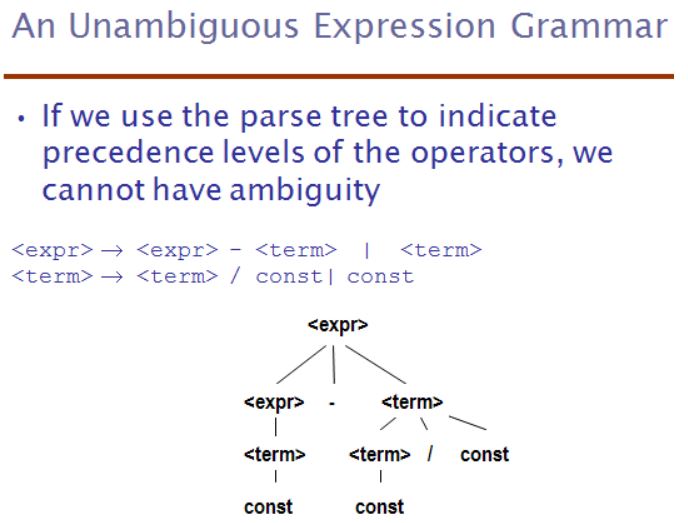
Parse Trees - hierarchical structure
 |
 |
The grammar is the following:
<assign> → <id> = <expr>The sentence
<id> → A | B | C
<expr> → <expr> + <expr>
| <expr> * <expr>
| ( <expr> )
| <id>

| In the above left parse tree, the multiplication operator is generated lower in the tree, which could indicate that it has precedence over the addition operator in the expression. However, the above right parse indicates just the opposite. So, these two conflict on precedence of operators. |
There is an unambiguous grammar for the above expression
which follow the order of MATH.
(See Example 3.4 on page 120) There is an additional nonterminal, <term>.
<assign> → <id> = <expr>No matter, you get from leftmost derivation or rightmost derivation,
<id> → A | B | C
<expr> → <expr> + <term>
| <term>
<term> → <term> * <factor>
| <factor>
<factor> → ( <expr> )
| <id>
| Leftmost derivation:
<assign> => <id> = <expr> => A = <expr> => A = <expr> + <term> => A = <term> + <term> => A = <factor> + <term> => A = <id> + <term> => A = B + <term> => A = B + <term> * <factor> => A = B + <factor> * <factor> => A = B + <id> * <factor> => A = B + C * <factor> => A = B + C * <id> => A = B + C * A |
Rightmost derivation:
<assign> => <id> = <expr> => <id> = <expr> + <term> => <id> = <expr> + <term> * <factor> => <id> = <expr> + <term> * <id> => <id> = <expr> + <term> * A => <id> = <expr> + <factor> * A => <id> = <expr> + <id> * A => <id> = <expr> + C * A => <id> = <term> + C * A => <id> = <factor> + C * A => <id> = <id> + C * A => <id> = B + C * A => A = B + C * A |
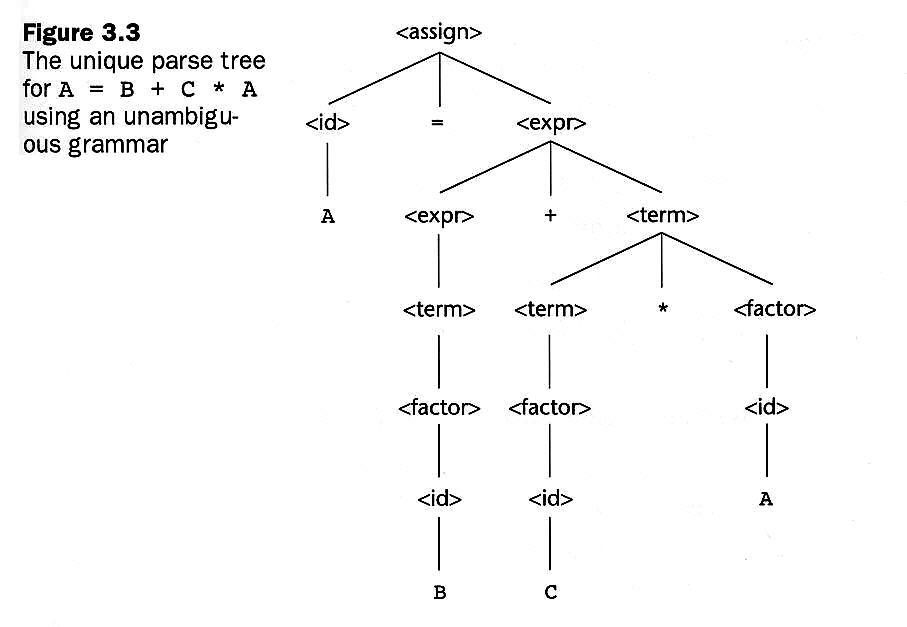
Exercise: Show a parse tree and leftmost derivation for A = C * B + A

For the statement, A
= B + C + A, you may have the following sequences of computation:
1. do B + C first,
after that sum of B and C
adds A, i.e. A = (B + C) + A
2. do C + A first,
after that B adds sum of C
and A, i.e. A = B + (C + A)
In mathematics, methods 1 & 2 get the same result.
In computer science,
1. If it is "integer computer arithmetic",
both methods get the same result.
2. If it is "floating-point addition",
two methods produce different results.
e.g..
Let floating-point values store seven digits of accuracy.
If we have a number 12,345,670
which will be stored as 1.234567*107.
(1.234567*107
+ 1) + 1 + 1 + 1 + 1 + 1 + 1 + 1 + 1 + 1
=1.234567*107 + 1 + 1 +
1 + 1 + 1 + 1 + 1 + 1 + 1
=(1.234567*107 + 1) + 1
+ 1 + 1 + 1 + 1 + 1 + 1 + 1
=1.234567*107 + 1 + 1 +
1 + 1 + 1 + 1 + 1 + 1
=(1.234567*107 + 1) + 1
+ 1 + 1 + 1 + 1 + 1 + 1
=1.234567*107 + 1 + 1 +
1 + 1 + 1 + 1 + 1
Keep going.... The answer =1.234567*107
1.234567*107 + 1 + 1 + 1 + 1 + 1 + 1 + 1 + 1 + 1 + 1
=1.234567*107 + (1 + 1 + 1 + 1 + 1 + 1 + 1 + 1 + 1 + 1)
=1.234567*107 + 10 The answer =1.234568*107
1.234567*107 is not equal to 1.234568*107
Look at page 130:
For the following grammar:BNF (Backus-Naur Form): collection of rules, method of syntax description. (See page 110)<if_stmt> → if <logic_expr> then <stmt>We can prove it as an Ambiguous Grammar:
| if <logic_expr> then <stmt> else <stmt>
<stmt> → <if_stmt> | <any non-if statement>
<if_stmt> → if <logic_expr> then if <logic_expr> then <stmt> else <stmt>Note: Which "if" does "else" match to? Most recent one?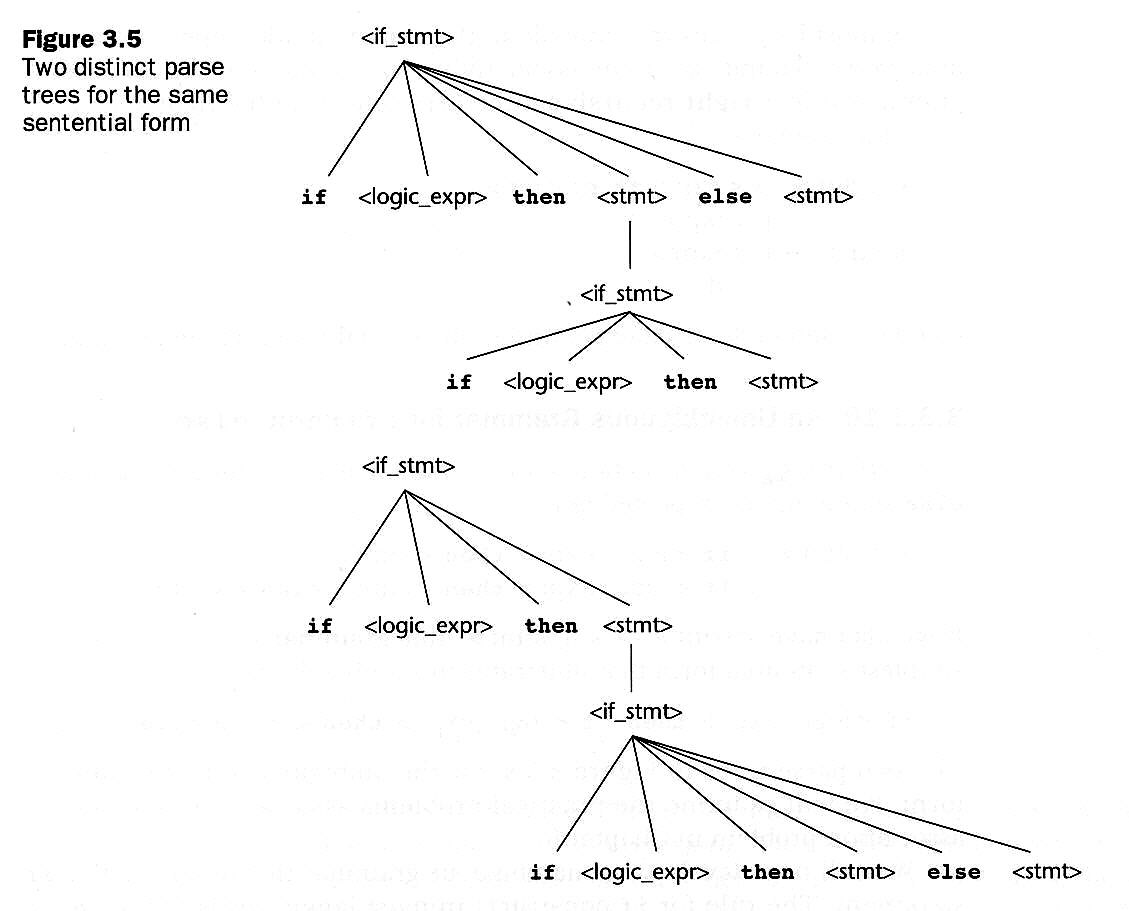
Unambiguous Grammar: (Page 132)
Exercise: Write a derivation & draw a parse tree for the following statement by the above grammar:
<stmt> → if <logic_expr> then if <logic_expr> then <stmt> else <stmt>
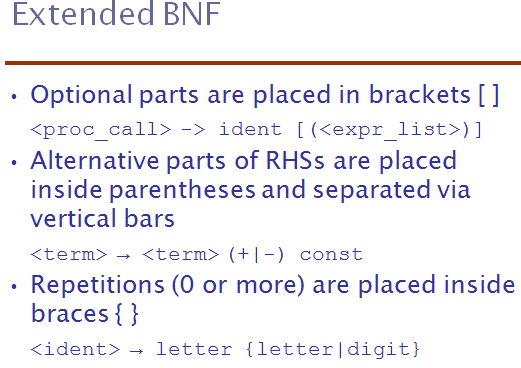
Example: (page 126)
